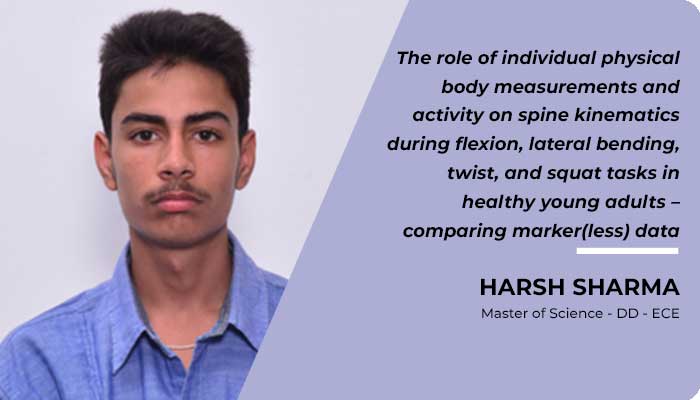Harsh Sharma received his Master of Science – Dual Degree in Electronics and Communication Engineering (ECE). His research work was supervised by Dr. Kavita Vemuri. Here’s a summary of his research work on The role of individual physical body measurements and activity on spine kinematics during flexion, lateral bending, twist, and squat tasks in healthy young adults – comparing marker(less) data:
Physical exercises and gross motor skills support the spine and the body’s lower extremities. Understanding the relationship between physical characteristics and activity to kinematic properties of the spine has implications for sports, occupational tasks, clinical diagnosis and prognosis. This study aimed to categorize spine kinematics and the lumbopelvic-hip segments from flexion, lateral-bend, twist, and squat exercises by examining the correlations to body-mass index (BMI), waist-to-hip ratio (WHR), and physical activity levels in healthy young adults. The data was collected from a marker-based opto- electronic motion capture setup and a marker-less motion capture with the RGB camera of a standard mobile phone. Comparing the accuracies of the two techniques on the same data set is important to develop inexpensive (RGB camera) diagnostics.
Sixty-two participants (40 Male, 22 female) participated in the study. The angular displacement of the spine and knee/hip for each exercise was extracted by vector analysis using a single reference node/marker. The analysis showed no significant correlations of angular displacements values for the four movements with BMI or WHR. The physical activity level of male participants is significantly correlated with angular displacements for the flexion (p<0.001) and lateral-bend (p value ranges from 0.001-0.04) and weakly correlated (but not significant) for twist exercises. The physical activity level shows a significant correlation for only flexion (p<0.001) in female participants. BMI is negatively correlated in male participants for the squat movement, while WHR and physical activity show positive associations. In the female cohort, a negative correlation with BMI, WHR, and physical activity level is observed for the squat movement. The findings emphasize the criti- cal role of physical activity on musculoskeletal flexibility in young, healthy adults. The angles estimated using both techniques were comparable and significantly correlated across participants and exercises.
June 2023

